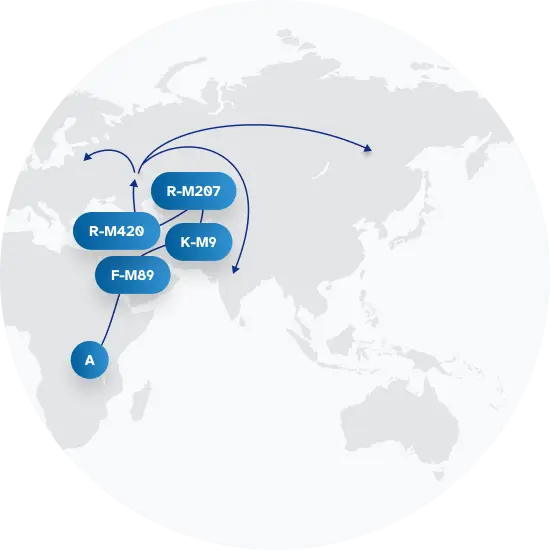Explore the Family Name Rai
How common is the last name Rai in the United States?
According to data from the Decennial U.S. Census, the surname Rai has seen a significant rise in popularity between 2000 and 2010. In 2000, Rai was ranked 13,290th in popularity, with 2,106 individuals carrying the name. However, by 2010, it had climbed to the rank of 6,418 with an impressive count of 5,295 people. This represents a substantial increase of 151.42% over the decade. The proportion of people with the surname Rai per 100,000 also increased during this period, going from 0.78 to 1.8, indicating a percentage change of 130.77%.
| 2000 | 2010 | Change | |
|---|---|---|---|
| Rank | #13,290 | #6,418 | 51.71% |
| Count | 2,106 | 5,295 | 151.42% |
| Proportion per 100k | 0.78 | 1.8 | 130.77% |
Race and Ethnicity of people with the last name Rai
The Decennial U.S. Census data reveals changes in the ethnic identity of individuals with the surname Rai over the same time frame. The largest ethnicity group associated with the surname is Asian/Pacific Islander, which grew from 81.77% in 2000 to 89.99% in 2010, an increase of 10.05%. All other ethnicities decreased, with those identifying as two or more races dropping significantly from 9.50% to 3.31%, a decline of 65.16%. White individuals with the surname Rai also fell from 5.41% to 3.68%, while Hispanic and Black populations experienced decreases of 10.83% and 23.19% respectively. Interestingly, the American Indian and Alaskan Native group saw an increase of 50.00%, though they still represent a small fraction of the Rai population at 0.57% in 2010.
| 2000 | 2010 | Change | |
|---|---|---|---|
| Asian/Pacific Islander | 81.77% | 89.99% | 10.05% |
| White | 5.41% | 3.68% | -31.98% |
| Two or More Races | 9.5% | 3.31% | -65.16% |
| Hispanic | 1.57% | 1.4% | -10.83% |
| Black | 1.38% | 1.06% | -23.19% |
| American Indian and Alaskan Native | 0.38% | 0.57% | 50% |
Rai ancestry composition
23andMe computes an ancestry breakdown for each customer. People may have ancestry from just one population or they may have ancestry from several populations. The most commonly-observed ancestry found in people with the surname Rai is Northern Indian & Pakistani, which comprises 48.7% of all ancestry found in people with the surname. The next two most common ancestries are Chinese (21.3%) and Southern Indian & Sri Lankan (6.1%). Additional ancestries include British & Irish, Bengali & Northeast Indian, French & German, Manchurian & Mongolian, and Eastern European.
Ready to learn more about your ancestry? Get the most comprehensive ancestry breakdown on the market by taking our DNA test. Shop 23andMe
| ANCESTRY BREAKDOWN | COMPOSITION |
|---|---|
| Northern Indian & Pakistani | 48.7% |
| Chinese | 21.3% |
| Southern Indian & Sri Lankan | 6.1% |
| Other | 23.9% |

Possible origins of the surname Rai
Your DNA provides clues about where your recent ancestors may have lived. Having many distant relatives in the same location suggests that you may all share common ancestry there. Locations with many distant relatives can also be places where people have migrated recently, such as large cities. If a large number of individuals who share your surname have distant relatives in a specific area, it could indicate a connection between your surname and that location, stemming from either recent ancestral ties or migration.
Based on 23andMe data, people with last name Rai have recent ancestry locations spanning a few countries, mostly in Pakistan, and Nepal.
| RECENT ANCESTRY Location | Percentage |
|---|---|
| Punjab, Pakistan | 31.80% |
| Eastern Development Region, Nepal | 17.50% |
| Kerala, India | 9.70% |
| Tamil Nadu, India | 8.40% |
| Merseyside, United Kingdom | 7.80% |
What Rai haplogroups can tell you
Haplogroups are genetic population groups that share a common ancestor on either your paternal or maternal line. These paternal and maternal haplogroups shed light on your genetic ancestry and help tell the story of your family.
The top paternal haplogroup of people with the surname Rai is R-Y7, which is predominantly found among people with Central & South Asian ancestry. Haplogroup R-Y7 is descended from haplogroup R-M420. Other common haplogroups include O-F8 and R-L23, which are predominantly found among people with East Asian & Indigenous American and European ancestry. Other surnames with similar common haplogroups are: Rahman, Sheikh, Sharma, Mehta, Hussain, Singh, Shah, Das, Malik, Kumar.
The most common maternal haplogroups of people with Rai surname are: M, H, D4. These most commonly trace back to individuals of European ancestry.
 Paternal Haplogroup Origins R-M420
Paternal Haplogroup Origins R-M420Your maternal lineage may be linked to the Han
Members of haplogroup D are found in both northern and southern Han Chinese populations at low to moderate frequencies. The Han people, who all share the same language and similar cultural practices, are the largest ethnic group in the world, with about 1.2 billion people. Historical evidence shows that Han people are descendants of the ancient Huaxia tribes that come from northern China, and Han language and culture only expanded into southern China in the last 2,000 years. The spread of Han people and culture from northern to southern China was likely driven by warfare and famine in the north.

What do people with the surname Rai have in common?
Spoiler alert: it's complicated. People with the same last name are usually no more genetically similar than a randomly sampled group of people from the same population. That said, people with the same surname are more likely to have similar ancestries than randomly sampled individuals. The reason is the tendency of people with similar cultural or geographical backgrounds to preferentially mate with one another. That's why people who share a surname may be more likely to share traits and tendencies in common than people within the general population. Check out the percentages below to see the prevalences of tastes, habits, and traits of people with your surname compared with prevalences among 23andMe users.
Preferences
Traits
Habits
Wellness

Migraine
A severe headache characterized by intense pain, sensitivity to light and sound, and often accompanied by nausea and vomiting.
"Rai" Surname 10.0%
23andMe Users 16.4%
Are health conditions linked to the last name Rai?
The short answer is that, if there is an association between surname and health, it's usually more about your ancestry than your name. Individuals with a given surname are no more genetically similar than the general population but often have similar ancestries. The populations of people associated with those shared ancestries often have sets of genetic variations, also known as alleles, in common. Some of those alleles are associated with a greater likelihood of developing certain diseases.
Disease variant frequency by ancestry
Disease allele frequencies in populations associated with the surname Rai are shown below. Important Note: not everyone with a disease allele will develop these health condition










